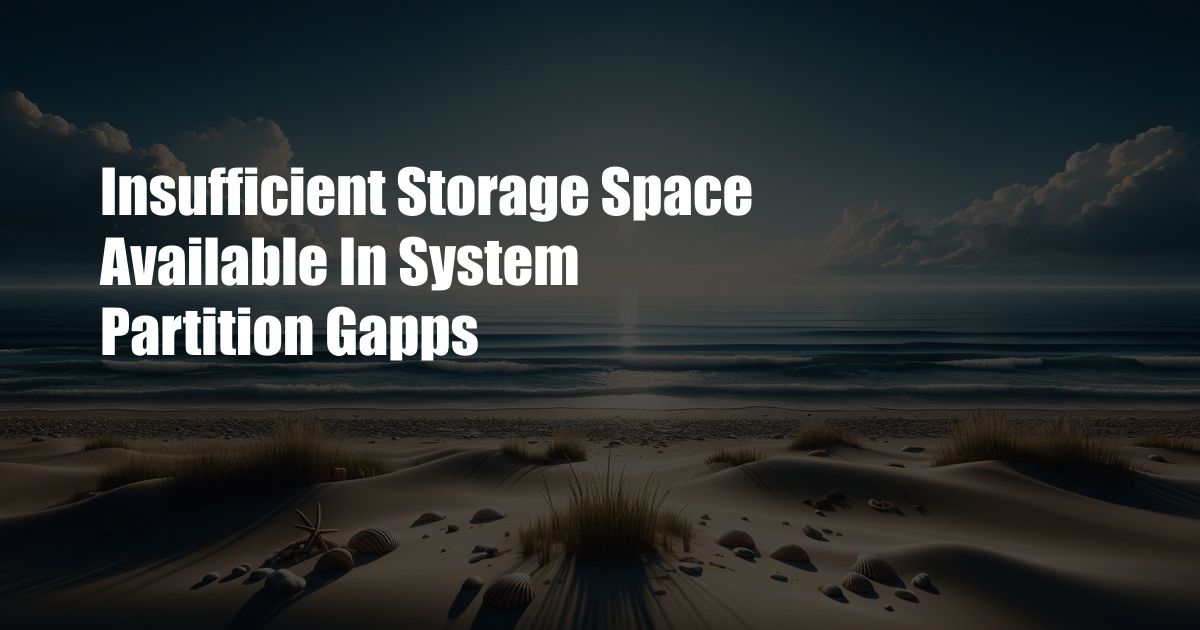
Insufficient Storage Space Available in System Partition GApps
Have you ever encountered the dreaded “Insufficient storage space available in system partition” error while trying to update or install apps on your Android device? As a tech enthusiast, I’ve faced this challenge on numerous occasions, and it can be incredibly frustrating. However, after delving into the issue and exploring various solutions, I’m confident I can guide you through this storage conundrum.
Delving into System Partitions and GApps
Before we address the storage issue, let’s shed light on some fundamental concepts. System partitions are allocated storage areas on Android devices specifically designed for the operating system (OS), boot files, and critical system applications. Google Apps (GApps) encompass essential Google services such as the Play Store, Gmail, and Maps, which are usually pre-installed on Android devices.
Understanding the Storage Crunch
The “Insufficient storage space available in system partition” error often occurs when your system partition becomes overcrowded. This can be caused by a variety of factors, including:
– Accumulated cache files and app data
– Unnecessary system updates
– Bloated GApps packages
– Incompatible or outdated apps
When the system partition runs out of space, it can hinder crucial system functions, such as software updates and app installations. Therefore, it’s essential to address this issue promptly to ensure the smooth operation of your device.
Troubleshooting and Solutions
Now that we understand the causes, let’s explore effective solutions:
– Clear Cache and Data: Head to Settings > Apps & notifications > See all apps, select individual apps, and clear their cache and data.
– Review System Updates: Go to Settings > System > System update and check for any available updates. Once downloaded, restart your device to apply them.
– Uninstall Redundant GApps: If your device has custom GApps installed, consider removing unnecessary packages.
– Remove Unwanted Apps: Go through your installed apps and eliminate any you no longer use.
– Install a Custom Recovery: If other methods fail, consider installing a custom recovery like TWRP to perform advanced partitioning and wipe operations.
Expert Advice and Tips
In addition to the aforementioned solutions, here are some expert recommendations:
– Use a Storage Analyzer App: Utilize apps like DiskUsage or Storage Analyzer to identify and delete large files or folders.
– Move Apps to External Storage: If your device supports external storage, move apps to an SD card to free up space on the system partition.
– Disable Unnecessary Bloatware: Identify and disable any pre-installed apps (bloatware) you don’t use or need.
– Regular Data Backups: Always back up your important data before performing any major changes to your device.
By following these tips, you can effectively address the “Insufficient storage space available in system partition” issue on your Android device and ensure it runs smoothly and efficiently.
FAQs
Q: Can I merge the system partition with the data partition?
A: Yes, it’s possible to merge partitions using a custom recovery like TWRP, but it’s a more advanced operation and not recommended for beginners.
Q: Will clearing my cache and data delete my files and apps?
A: No, clearing cache and data only removes temporary files and app settings. Your files and apps will remain intact.
Q: Is it safe to remove GApps?
A: Removing GApps can affect the functionality of some apps and Google services. It’s advisable to only remove GApps if you’re comfortable with the potential consequences.
Conclusion
Insufficient storage space in the system partition is a common issue that can be easily resolved with the right approach. By implementing the solutions and expert advice outlined in this article, you’ll be able to reclaim valuable storage space and restore the optimal performance of your Android device. I encourage you to share your experiences or any insightful solutions you’ve discovered in the comments below. Keep exploring and stay tuned for more tech-related insights!

 Hogki.com Trusted Information and Education News Media
Hogki.com Trusted Information and Education News Media